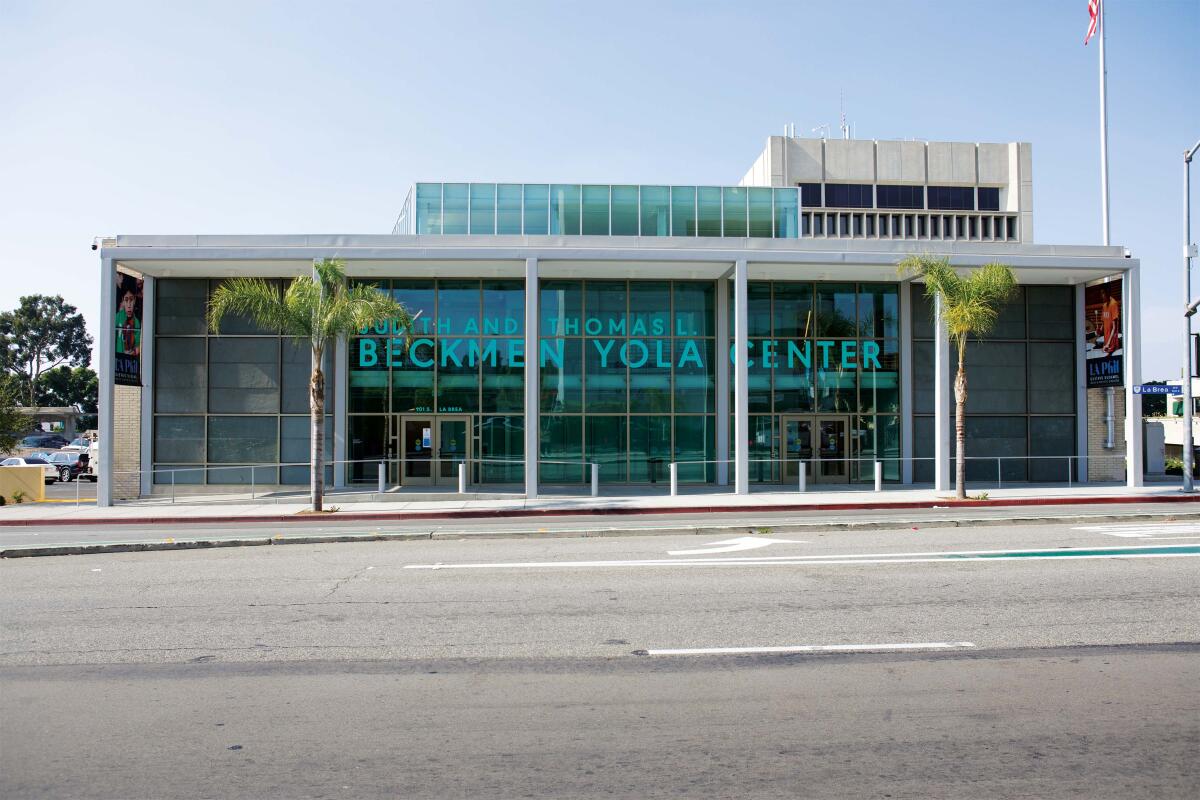Pitch-Perfect Renewal: The LA Phil’s YOLA Center is an Inglewood Community Resource

Nothing reads “blight” like empty buildings lining a city’s main thoroughfare.
This may have been at the forefront of Inglewood residents’ minds when they passed by a dilapidated, ancient bank building on South La Brea Avenue adjacent to City Hall. Something had to be done. Enter a dynamic mayor, a “starchitect,” and a laudable goal to give underprivileged and underrepresented youth a chance to experience something they could only dream about - the opportunity to learn the theory and practice of classical music, overseen by none other than members of the L.A. Philharmonic. Combining forces to create a landmark building out of a forgotten space and a dream, the now-open Judith and Thomas L. Beckman YOLA (Youth Orchestra Los Angeles) Center represents the spirit of the City of Inglewood and its dedication to its residents, youth and their growth for the future.
“This building was first a Security Pacific Bank, then it was a Burger King, and temporarily a STEM center before being vacated and land banked by the city. And so now it’s transitioned on and been reborn as a cultural anchor for the city,” Mayor James T. Butts Jr. told KCRW in August 2021. Surely, the building was often on his mind, sitting on the adjacent parcel to his city office. The dilapidated structure, built in 1965, nonetheless had useable mid-century modern bones, so a teardown and rebuild was unnecessary. But while the structure of the exterior has largely remained the same, inside the transformation has been nothing less than monumental.
Frank Gehry, among the greatest living architects and huge supporter of classical music (one need only look to his Walt Disney Concert Hall in downtown L.A. to appreciate his dedication to the art) was brought in to transform the building. Inside, the ceiling was raised and the floor lowered to give the structure soaring acoustics more befitting of a concert hall than a place to cash a check, and all surfaces were updated and renovated to create a welcoming place for teachers, students, families and patrons of the arts. Another factor uncommon to Gehry’s projects - the goal for the YOLA Center was to be price-conscious, befitting YOLA’s nonprofit status. The projected budget of $14.5 million was paltry compared to the cost of say, the Walt Disney Concert Hall (which cost $130 million in 2003). This made adaptive reuse a must and innovative materials and construction imperative.
That said, the interiors and exteriors of the center are inspiring - a sweeping, 45-foot ceiling with glass roof provides immersive sound for the rehearsal and practice spaces while simultaneously bathing the 4,500-square-foot interior in natural light. The understated, glass-wall exterior exemplifies the original structure’s simple and clean modernism, while featuring some subtle adornments, lighting and landscaping to highlight its reuse.
The Center comes at a pivotal moment for the nation - the U.S. is in the midst of serious reflection on issues of race, diversity, equity and inclusion. The YOLA Center is effectively shouting to the world: Classical music and the arts belong to everyone. This is a directive championed by founder Gustavo Dudamel, who based groundwork of the YOLA experience on “El Sistema,” the immersive classical arts program he experienced in his native Venezuela.
Believing that a cultural institution should feature faces of every creed and color, Dudamel worked tirelessly during his tenure to grow the program, launched in 2007, to increase participation among youth, especially those from Black and Brown communities that are historically underrepresented in the world of classical music. Outreach and expansion by Dudamel included bringing 96 deserving YOLA students to Mexico City during the L.A. Phil’s residency there. The YOLA Center will provide cost-free education and instruments to up to 1,300 Inglewood students in an after-school program. They will be taught the fundamentals and theory of performing and learn the skills and synergy required to be part of a functioning symphony orchestra.
In addition to youth programming, the YOLA Center will feature collaborative space for musicians and educators from around the world. While COVID-19 restrictions have delayed the full implementation of programming at the Center, L.A. Philharmonic leadership is anxious to bring 300 students in as soon as it is safely possible.
The Center played host to the YOLA National Symposium last October, the first such event in the venue, as a hybrid in-person/virtual event. The symposium brought together world-renowned educators, artists, social justice leaders, and youth advocates in a spirited discussion on best practices, methods to innovatively share their artistic vision, and how to best reach those underrepresented in the world of classical music. The 2021 theme? Simply (and appropriately), “Change.”
And this change is apparent throughout both the YOLA Center and the city of Inglewood in general, which is creating a rubric for what a vibrant American city is and can be. By bringing institutions such as the YOLA Center to Inglewood, the city’s leadership and decision-makers are redefining who has access to society’s fine arts communities.
The L.A. Philharmonic has cast aside long-entrenched racial and social barriers to youth from minority and/or low-to-middle-income families. With the Center a beacon for the arts for both patrons and the student picking up their first violin or flute, the overriding theme of equity (something that music so naturally provides by bringing people together) rings as clearly as a beautifully written symphony.